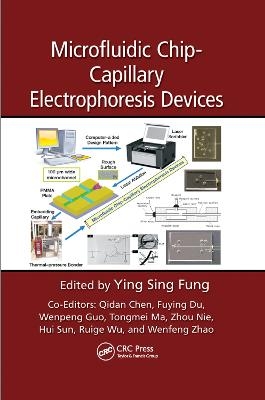
Microfluidic Chip-Capillary Electrophoresis Devices
CRC Press (Verlag)
978-0-367-37748-9 (ISBN)
- Titel z.Zt. nicht lieferbar
- Versandkostenfrei
- Auch auf Rechnung
- Artikel merken
The book gives an overview of the development of MC and CE technology as well as technology that now allows for the fabrication of MC-CE devices. It describes the operating principles that make integration possible and illustrates some achievements already made by the application of MC-CE devices in hospitals, clinics, food safety, and environmental research. The authors envision further applications for private and public use once the proof-of-concept stage has been passed and obstacles to increased commercialization are addressed.
A summary of the current methodology and application of MC-CE devices, including their merits, limitations, and potential, closes the book. It highlights the path to be taken for future development of MC-CE and anticipates new advances in technology that will increase their performance and use as powerful analytical tools. With enhanced power, their scope of applications will widen and yield new benefits to researchers and the general public.
Dr. Ying Sing Fung received his BSc and MPhil from the University of Hong Kong, Hong Kong SAR, China, in 1975 and 1977, respectively, and his PhD from the Imperial College of Science, Technology and Medicine, University of London, United Kingdom, in 1980. He is currently associate professor in the Department of Chemistry at the University of Hong Kong. He has been a member of the editorial board of Journal of Chemical Education (Chinese Chemical Society) and Journal of Biochemical and Biophysical Methods (Elsevier Science, the Netherlands). He holds four patents and has authored or co-authored 12 books and reviews, more than 130 journal articles, and 290 conference papers. Dr. Qidan Chen received her PhD from the University of Hong Kong, Hong Kong SAR, China, in 2010. She is associate professor at Zhuhai College, Jilin University. Her research interests include the application of nanomaterial in microfluidic-chip capillary electrophoresis (MC-CE) devices and in food testing research, using various international advanced technologies based on semiconductor nanoparticles, microfluidic electrophoresis devices, and laser fabrication techniques, and the development of novel analytical methodology for the determination of toxic environmental pollutants and new analytical methods for the determination of contaminants in food. She has more than 20 publications in journals and presentations at international conference proceedings. She is a co-editor of this book and the principal author of chapters 10 and 11. Dr. Fuying Du received her PhD from the University of Hong Kong, Hong Kong SAR, China, in 2012. She took a postdoctoral position in the Department of Water Quality Engineering, Wuhan University for two years prior to appointment to her current position as a lecturer in the Department of Water Quality Engineering, Wuhan University. Her research interests include electrochemical sensor and electrochemical bio
Microfluidic Chip-Capillary Electrophoresis: Expanding the Scope of Application for On-Site Analysis of Difficult Samples. Instrumentation and Facilities I: Fabrication of Microfluidic Chip-Capillary Electrophoresis Device. Instrumentation and Facilities II: Manipulating Nanofluids for Desired Operations to Achieve Intended Application by MC-CE Device. Single-Channel Mixing: Extending Analytical Range to Handle Samples with High Analyte Variation for Profiling Urinary Organic and Inorganic Anions. Dual-Channel Mixing: Standard Addition by Dual-Channel Continuous Flow Mixing for Assay of Complex Nephrolithiasis Biomarkers in Urine. Sample Cleanup and Analyte Enrichment: Integrating MIP/SPE with ME-MC-CE Device to Enhance Sample Cleanup and Multidimensional Analyte Enrichment for Hourly Determination of Atmospheric Carbonyl Compounds. Enhancing Separation Efficiency: On-Chip Multidimensional Separation and Determination of Urinary Proteins by MC-CE Device. Improving Detection Selectivity: MC-CE Device Integrated with Dual Opposite Carbon-Fiber Microdisk Electrodes Detection for Determining Polyphenols in Wine. Enhancing Detection Versatility: MC-CE Device with Serial Dual-Electrode Detection for Determining Glutathione Disulfide and Glutathione in Pharmaceutical Supplement. Detecting Optically Inactive Analyte: MC-CE Device Integrated with QDs/LIF Detection for Determination of Acrylamide in Food. Quantum Dots-Enhanced Fluorescence Detection: Immobilized Quantum Dots for Laser-Induced Fluorescence Detection of Organophosphorus Pesticides in Vegetables. On-Site Assay by Portable UV Detector: MC-CE Device for Authenification of Chinese Medicine. On-Chip Binding Assay: MC-CE Device Integrated with Multisegment Circular-Ferrofluid-Driven Micromixing Injection for Assay of Free Bilirubin and Albumin Residual Binding Capacity for Bilirubin. Counting Organelles: Direct Counting of Mitochondrial Numbers. Indirect Assessment of Organelles in Cell Extract: Determination of M
| Erscheinungsdatum | 24.09.2019 |
|---|---|
| Verlagsort | London |
| Sprache | englisch |
| Maße | 156 x 234 mm |
| Gewicht | 568 g |
| Themenwelt | Schulbuch / Wörterbuch |
| Naturwissenschaften ► Biologie | |
| Naturwissenschaften ► Chemie ► Analytische Chemie | |
| Technik ► Lebensmitteltechnologie | |
| ISBN-10 | 0-367-37748-9 / 0367377489 |
| ISBN-13 | 978-0-367-37748-9 / 9780367377489 |
| Zustand | Neuware |
| Haben Sie eine Frage zum Produkt? |
aus dem Bereich


